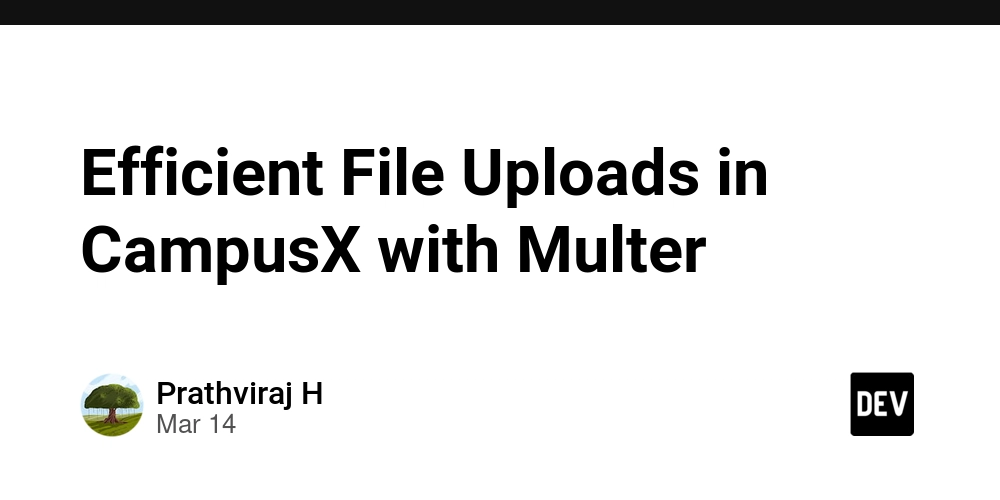Efficient File Uploads in CampusX with Multer
CampusX handles file uploads efficiently using Multer, a middleware for handling multipart/form-data. This is essential for managing profile pictures, post images, and other media assets that users upload. Why Multer? Efficient Processing: Multer processes files on the server before storing or passing them to a cloud service (e.g., Cloudinary). Custom Storage Handling: Files are temporarily stored in ./public/temp before being uploaded to Cloudinary for optimized delivery. Security & Control: Limits the type and size of files, reducing unnecessary server load. How Multer Works in CampusX import multer from "multer"; const storage = multer.diskStorage({ destination: function (req, file, cb) { cb(null, "./public/temp"); }, filename: function (req, file, cb) { const uniqueSuffix = Date.now() + "-" + Math.round(Math.random() * 1e9); cb(null, file.fieldname + "-" + uniqueSuffix); }, }); export const upload = multer({ storage, }); Temporary Storage: Files are first stored locally in ./public/temp. Unique Naming: Prevents filename collisions by appending a timestamp and random number. Integration with Cloudinary: Once uploaded, files are transferred to Cloudinary, and the temporary file is deleted. Usage in CampusX When users upload an avatar, post image, or cover image, Multer handles the initial processing. The file is then uploaded to Cloudinary using the uploadOnCloudinary function. After upload completion, the local temporary file is deleted. By using Multer efficiently, CampusX ensures smooth file uploads while offloading long-term storage to Cloudinary, reducing server load and improving performance.

CampusX handles file uploads efficiently using Multer, a middleware for handling multipart/form-data. This is essential for managing profile pictures, post images, and other media assets that users upload.
Why Multer?
- Efficient Processing: Multer processes files on the server before storing or passing them to a cloud service (e.g., Cloudinary).
-
Custom Storage Handling: Files are temporarily stored in
./public/tempbefore being uploaded to Cloudinary for optimized delivery. - Security & Control: Limits the type and size of files, reducing unnecessary server load.
How Multer Works in CampusX
import multer from "multer";
const storage = multer.diskStorage({
destination: function (req, file, cb) {
cb(null, "./public/temp");
},
filename: function (req, file, cb) {
const uniqueSuffix = Date.now() + "-" + Math.round(Math.random() * 1e9);
cb(null, file.fieldname + "-" + uniqueSuffix);
},
});
export const upload = multer({
storage,
});
-
Temporary Storage: Files are first stored locally in
./public/temp. - Unique Naming: Prevents filename collisions by appending a timestamp and random number.
- Integration with Cloudinary: Once uploaded, files are transferred to Cloudinary, and the temporary file is deleted.
Usage in CampusX
- When users upload an avatar, post image, or cover image, Multer handles the initial processing.
- The file is then uploaded to Cloudinary using the
uploadOnCloudinaryfunction. - After upload completion, the local temporary file is deleted.
By using Multer efficiently, CampusX ensures smooth file uploads while offloading long-term storage to Cloudinary, reducing server load and improving performance.










































































































































































![[The AI Show Episode 142]: ChatGPT’s New Image Generator, Studio Ghibli Craze and Backlash, Gemini 2.5, OpenAI Academy, 4o Updates, Vibe Marketing & xAI Acquires X](https://www.marketingaiinstitute.com/hubfs/ep%20142%20cover.png)



























































































































![[FREE EBOOKS] The Kubernetes Bible, The Ultimate Linux Shell Scripting Guide & Four More Best Selling Titles](https://www.javacodegeeks.com/wp-content/uploads/2012/12/jcg-logo.jpg)



![From drop-out to software architect with Jason Lengstorf [Podcast #167]](https://cdn.hashnode.com/res/hashnode/image/upload/v1743796461357/f3d19cd7-e6f5-4d7c-8bfc-eb974bc8da68.png?#)






































































































.png?#)




.jpg?#)
































_Christophe_Coat_Alamy.jpg?#)







































































































![Rapidus in Talks With Apple as It Accelerates Toward 2nm Chip Production [Report]](https://www.iclarified.com/images/news/96937/96937/96937-640.jpg)









































































































































